
The die and the plate were produced by De La Rue & Co. who also recess printed the stamps in the UK.
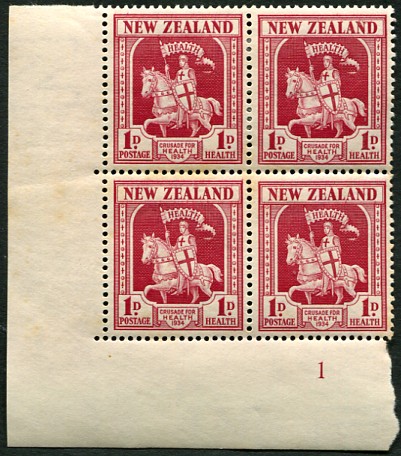
The 1934 design shows a mounted crusader and the design was by J. Berry.

The stamps cost 2d, 1d for postage and 1d which went towards health camps for children.
The paper was Wiggins, Teape watermarked multiple NZ and star and the stamps had a comb perforation of 14 x 13½.
A single plate was made with the stamps in 8 rows of 10 and the plate number 1 appears below the second stamp in the bottom margin.
Variable First Day of Issue
This was the first time that health stamps had been printed abroad. The stamps arrived from London on the Rangitiki which berthed in Auckland early in the morning of 24 October and they were all sent to the postal authorities in Wellington where they would arrive that evening before being placed on sale in Wellington on 25 October.
First day covers postmarked in Wellington (and two very questionable covers in Tauranga) are known postmarked on 25 October while in other areas the first date is 26 October or later.
The Evening Post of Wellington on 25 October reported a parliamentary answer that afternoon that the Health stamps were now on sale. The Bay of Plenty Times reported on 27 October that the stamps were now on sale [1]. As its area covers Tauranga, it appears that the stamps were actually first issued there on 26 or 27 October, not 25 October.
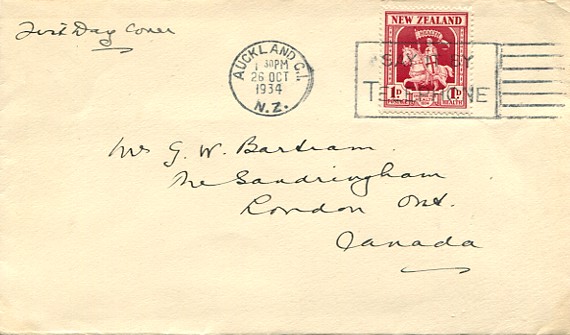
Auckland: 26 October
The New Zealand Herald of 29 October stated that the stamps arrived in Auckland on Friday 26 October and were immediately put on sale at the principal post offices.
An example postmarked there at 1.30 pm on 26 October and addressed to Canada is shown.
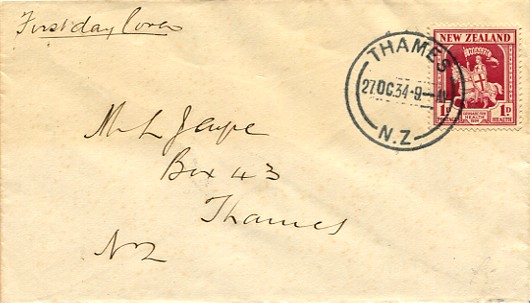
Thames: 27 October
It therefore appears that there was not a single "first day of issue" in the North Island, but stamps were put on sale when they arrived at a post office. As the stamps were distributed from Wellington, that explains why they were issued there first on 25 October.
Many smaller towns in the north will have received their stamps via Auckland late on 26 October or on 27 October and so their first day of issue was 27 October.
An example cover postmarked in Thames on Saturday 27 October and addressed locally is shown.
It would be the first day of issue there.
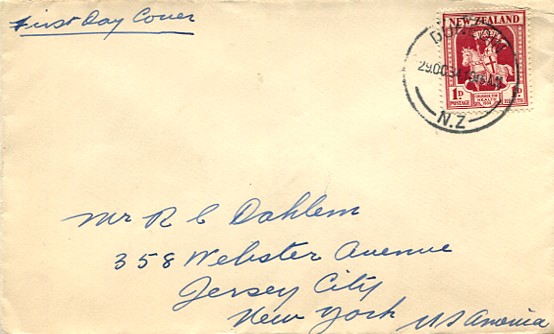
South Island: 29 October
The stamps would be sent to Lyttleton on the overnight ferry and so would be in Christchurch on Friday 26 October. Some attempt at coordinating the first day of issue was made in the South Island where most offices issued the stamps on Monday 29 October although a couple jumped the gun [2].
The Press of Christchurch on Monday 29 October stated that they were now on sale while, on Saturday 27 October, the Evening Star of Dunedin and the Otago Daily Times stated that they would be on sale in all post offices on the Monday, i.e. 29 October.
The example cover is postmarked in Dunedin on 29 October and is addressed to New York.
As there was no prior notice of the date of issue, covers postmarked on the first day of issue in Wellington are very rare while covers postmarked elsewhere on their local first day of issue are uncommon. Due to the lack of warning of the issue date, no illustrated first day covers were produced.
It is far from clear why there was such a rush to issue the stamps rather than have a coordinated issue date as in all other years.
Dates
- 1934 issued in Wellington on October 25, withdrawn 28 Feb 1935
Numbers printed
- 1,040,000
Numbers sold
- 279,120
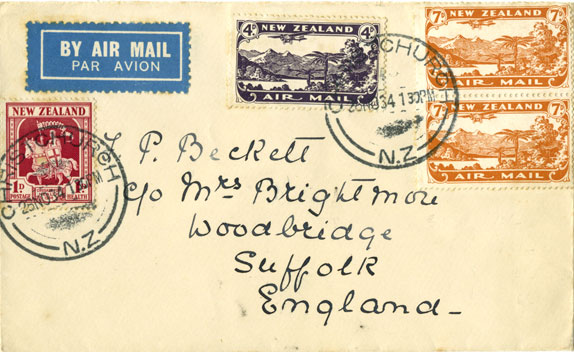
Postmarked November 1934
This cover shows the 1934 Health stamp postmarked in Christchurch on 28 November 1934 and sent on the first flight of the new regular service from Australia to Britain.
It was sent from Auckland to Sydney on the Monterey on 30th November - 4th December. It then went from Sydney to Cootamundra by rail and was flown from there to Charleville where it joined the service from Brisbane to the UK.
It is franked with 1s 7d although the rate for the new service was 1s 6d.
Likely that the 1d Health stamp paid for a late fee.
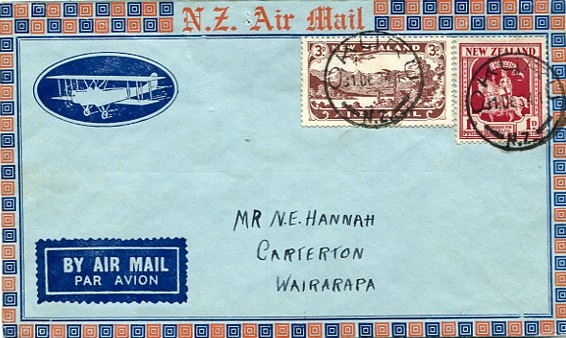
Postmarked December 1934
The next cover is postmarked in Okuru on 31 December and is addressed to Carterton which is north of Wellington. It was flown on the first return flight of the new regular South Westland service by Air Travel from Okuru to Hokitika.
It is seriously overfranked with the 3d airmail stamp and the 1934 health stamp
as the rquired postage was 1d.
The above information is taken from The Postage Stamps of
New Zealand Vol 1, published by the
Royal Philatelic Society of New Zealand in 1938,
and from contemporary New Zealand newspapers.
All scans were made by the author.
[1] Clark, R., 1934 Health: First Day of Issue,
The Kiwi, vol 68, p 137, July 2019.
[2] Favier P., 1934 Health First Day - Groundhog Day,
The Kiwi, vol 68, pp 133-135, July 2019.